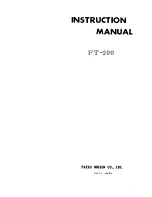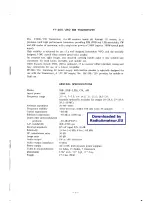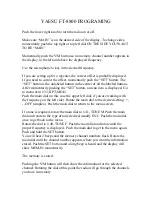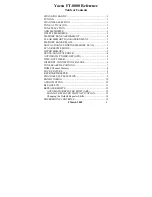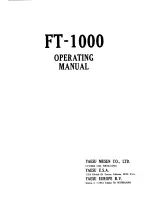
507 / Patriot Users Manual
Release 1.01
March 10, 2015
Part #74485
Printed in USA
Page
7
of 15
Figure 3 – Patriot Rear Panel
3. 507 Rear and Side Panels
(Refer to Figure 3 above)
3.1 Rear Panel Connections
DC POWER (2.1 mm coaxial power connector):
Connect an external regulated DC power source
of 10-15 volts to this. The center pin is positive
(+). The DC power supply should be able to
supply at least 1.5 amps. The power supply and
appropriate connector are not included in the
507 product package.
HEADPHONE/SPEAKER (1/8” stereo phone
jack): Accepts standard stereo headphones, with
monaural audio routed to left and right
earpieces. When a speaker is desired (see
Section 4.2), the audio is routed to the tip and
sleeve of the connector.
ANTENNA (BNC female): Connect a nominal
50 ohm impedance antenna.
KEY/PADDLE (1/8” stereo phone jack): The
Key/Paddle connector is a 1/8” stereo jack. As
provided by the factory, only a key or external
keyer may be used, with connection to the tip
and sleeve. If the user wishes to add a keyer as
part of the Arduino programming, both tip and
ring connections are accessible to the processor
for the paddle inputs.
3.2 Side-Tone Level Adjustment
A Side Tone level adjustment potentiometer can
be reached via an access hole on the Back panel
between the Headphone/Speaker and
Key/Paddle jacks. This adjustment is visible in
Figure 3 above. Set for a comfortable level.
3.3 User-Programmable Potentiometer (CW
Speed) FRONT PANEL
An additional internal potentiometer is available
for user programming (e.g., CW keying speed),
and is accessible via an access hole on the front
of the panel. This adjustment is visible in Figure
2.
3.4 Microphone Level Adjustment (RIGHT
SIDE)
The “MIC LEVEL IN” is a pot that is preset in
the factory to provide proper ALC action using
any TEN-TEC condenser type mic, e.g. models
707 or 708 or the hand mic model 702. To
achieve proper ALC action adjust this pot while
speaking into the microphone until the ALC
LED stays lit on voice peaks.
It is best not to use electret mics for this input.
This adjustment is visible in Figure 3 above.

















